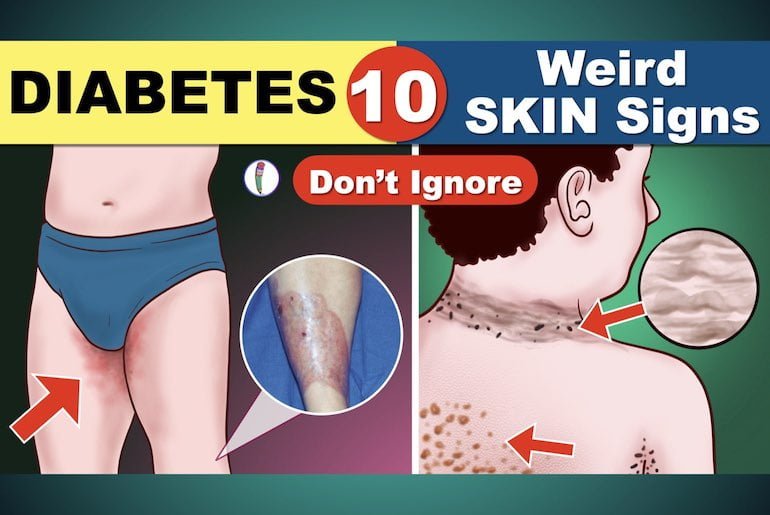In this blog we have discussed about Skin conditions from diabetes which will help you to diagnose early and prevent many future complications of diabetes.
Diabetes can affect many parts of our body, including our skin. Some skin changes are seen in later stage of diabetes but some changes are early indicator of diabetes. In fact, skin problems are sometimes the first sign that a person has diabetes.
Few skin lesions are typically seen in diabetes but some skin changes are general and anyone can have it. but people with diabetes get more easily
Skin conditions from diabetes:
Table of Contents
1. Diabetes signs on neck (Acanthosis nigricans):
Have you ever notice a dark patch (or band) of velvety skin on the back of your neck? Not only neck. It can be seen in armpit and groin areas. It is commonly seen in obese people. The medical term of this condition is Acanthosis nigricans and it is a sign of high blood glucose level. It may be the first sign that someone has diabetes.
If you notice this type of skin changes, consult a doctor. Early detection of diabetes can prevent many future complications (Ref)
2. Skin conditions from diabetes: Skin tags
Many people have few skin tags or skin growth and that is normal and harmless. However, numerous skin tags with blackish discolouration of skin could be a sign of high blood glucose level. These growths are most commonly seen on the eyelids, neck, armpit, and groin region.
3. Necrobiosis lipoidica:
In this you can see small raised solid bumps that look a lot like pimples; however, as the bump progresses, it turns into patches of swollen and hard skin. These patches are yellow, reddish, or brown in colour.
Other things you may notice:
– The surrounding skin has a shiny porcelain-like appearance
– Visible blood vessels
– Itchy and painful skin
– The skin disease will go through cycles where it is active, inactive, and then active again
This condition is medically termed as necrobiosis lipoidica. If you see this type of skin lesion, get tested for diabetes
4. Digital sclerosis (skin hardening or thickening)
About one third of people with type 1 diabetes have digital sclerosis. A thick, tight, waxy skin that develops on the back of the hands. The finger joints stiffen and are become difficult to move. Occasionally this skin problem occurs on the toes and forehead as well. Rarely, knees, ankles, or elbows may also stiffen.
Controlling blood glucose level and physical therapy may be helpful in this situation. You can also use Moisturizer to soften the skin
5. Diabetic dermopathy:
This skin condition causes spots and occasionally lines that create a barely noticeable depression in the skin. It’s commonly seen in people with diabetes. Medical it is termed as diabetic dermopathy. It generally forms on the shins and rarely on the arms, thighs, trunk, or other areas of the body.
The spot doesn’t cause any symptoms therefore many people mistake them for age spots. Unlike age spots, these spots and lines usually start to fade after 18 to 24 months. Diabetic dermopathy can also stay on the skin indefinitely.
6. Bullosis diabeticorum:
Very rarely people with diabetes can see blisters suddenly appearing on their skin. It can be a large blister, a group of blisters, or both. The blisters usually form on the hands, feet, legs, or forearms and look similar to the blisters that appear after a serious burn; however, these blisters are not painful unlike the one that develops after a burn.
This condition is called as bullosis diabetricorum or diabetic bullae.
7. Eruptive-xanthomatosis:
Eruptive-xanthomatosis is commonly seen in uncontrolled diabetes. The bumps that appear in this condition looks like pimples but they soon develop a yellowish color. Bumps generally appear on the buttocks, thighs, crooks of the elbows, or backs of the knees. They can appear on other parts of the body as well. Irrespective of the region, they are usually tender and itchy.
This yellow bumps will disappear promptly when diabetes is well-controlled (ref)
8. Frequent skin infections:
People with diabetes tend to get frequent bacterial or fungal skin infections.
Bacterial infections commonly seen in diabetes are
– Styes, which is infection of the glands of the eyelid
– Folliculitis or infection of the hair follicle
– Carbuncles or deep infections of the skin and the tissue underneath
Fungal infection is also very common in diabetes. It is most commonly seen in warm, moist folds of the skin like under the breasts, around the nails, between fingers and toes, corners of the mouth, armpits and groin region.
Common fungal infections include
- Jock itch
- Athlete’s foot
- Ringworm (a ring-shaped itchy patch),
- Vaginal infection that causes itching.
9. Open sores and wounds:
Uncontrolled (or poorly controlled) diabetes for a long time can lead to poor circulation and nerve damage. This makes it hard for your body to heal wounds especially on the feet. These open wounds are called diabetic ulcers.
If you have diabetes, you should check your feet every day for sores and open wounds.
10. Skin conditions from diabetes: itching
In diabetes there is often localized itching caused by a yeast infection, dry skin, or poor circulation. If poor circulation is the cause of itching then the itchiest areas are the lower parts of the legs.
You can treat itching yourself by:
- Limiting the frequency of bathing, particularly when the humidity is low
- Using mild soap with moisturizer
- Applying skin cream after bathing.
If you notice one or more of the above mentioned signs then its important that you correlate with other risk factors like obesity, family history of diabetes or having a sedentary lifestyle. Just having only 1 sign cannot be directly linked to diabetes. It can be associated with other diseases also.
But if you are 40+ and fall into this high risk groups then it’s better to check blood sugar level on a regular basis. Early detection of diabetes and precautionary measures can prevent many future complications
Know more about diabetes signs and symptoms Click here
A Visual Learning Platform





